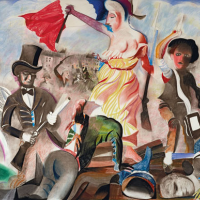33. CHARLES BLACKMAN

Artist's Statement
It has always been in my mind to do something about what I feel about Delacroixs wonderful painting, Liberty Leading the People, which I saw first with Arthur Boyd and Barry Humphries in Paris in 1963. Delacroix was at the forefront of the restlessness of his age. As I reincarnated the cobblestones and the broken wood I felt I was stepping over bodies and into history via the barricades. The Three Graces and The Cloud of Flowers - my intention was to send these beautiful girls to Georges Mora in heaven. Knowing Victoria always wants to go to Paris I thought, 'Let me send you to Paris in this drawing.'
Charles Blackman, 26 January 1993, Woollahra, Sydney
It is the most basic of maxims that all art grows from other art every work will be a development of, or reaction to, that which came before. All the new isms of the twentieth century were simply artists building on the work of their predecessors, or quite deliberately trying to be separated from it. Post-Impressionism growing from Impressionism, then the Cubists picking up on the idea and pushing to its limits before the Purists turned to abstraction in its simplest form. And while the avant-garde constantly pushed the boundaries, so too the traditionalists pushed back, striving to keep art on the narrow track of their masters. In Australia that particular battle was fought out in the 1930s, with the attempt to create a formal Academy of Art and the Contemporary Art Society that quickly sprang up to oppose it. In the manner of the times, the battle was carried on in the letters pages of the daily papers and at various art events around the town. At times the battle would be heated, as when students smashed up classical plaster casts at the National Gallery Art School. At others it was a formally presented argument, as with Keith Murdochs exhibition of French and British Contemporary Art, considered so radical the National Gallery of Victoria refused to have it darken its doors.
Charles Blackman, as a young modernist, was keen to be associated with all that was new, producing a form of expression that was both fresh and attractive, although not too radical as to alienate the newly emerging market for young contemporary artists in the post-war years. Blackman took from many forms German Expressionism, Post-Impressionism and contemporary illustration. The years after World War II were exciting as society as a whole sought to move on from the old world that had seen two international conflicts in less than three decades. Like many of his contemporaries, Blackman travelled overseas as soon as he could to learn from and experience all the art that had led him to his own personal expression. Visiting the great galleries of the world was a sure way of quickly realising that all artists are part of a great continuum and, however much they might try to reject the past, one cannot ignore the foundations on which all art is built.
Charles Blackman had kept to the figurative tradition, finding in the Antipodean Manifesto a way of voicing modernist ideals with a respect for traditional forms. Many Australian artists had been profoundly influenced by their overseas experiences, often in the most unlikely ways witness Albert Tuckers (1914-1999) homage to JMW Turners (1775-1851) views of the Thames that he produced in 1957. Blackman was happy to be inspired by works from the past, understanding that reference to the art of the past was the best way of picturing ones own place in the world. His Nude and her Reflection of 1988, a reimagining of Diego Velzquezs (1599-1660) Rokeby Venus (Venus at her Mirror), kept him close to his own style and imagery, but paying homage to Eugne Delacroixs (1798-1863) Liberty Leading the People was a step up in scale and complexity that would challenge any artist. A work so politically charged it was hidden away for much of the nineteenth century, the Delacroix was, and remains, an emblem of democracy and anti-establishment people power. No matter how devoted one might be to modernism, it is impossible to ignore the sheer grandeur and raw power of Liberty and her followers. Its appeal is both its consummate handling of the strongly graphic image, but also the underlying violence that adds a frisson of danger to the subject. For young Australians who had just lived through the war it was a mixed message we had come to nationhood simply through the stroke of a pen and an act of the British Parliament, but were acutely aware that war and violence could strip those freedoms away in a moment. Blackman might have made his reputation in sublime studies of schoolgirls and vases of flowers, but he was also conscious of being part of a much greater artistic tradition, and he was happy to tip his hat to the masters who had come before.
Gavin Fry, BA (Hons), MA MPhil